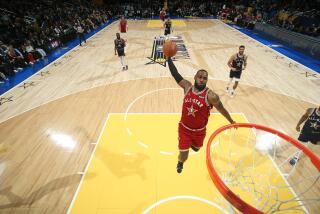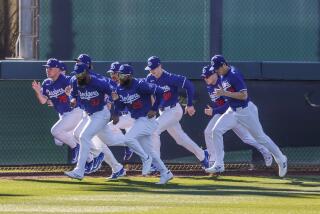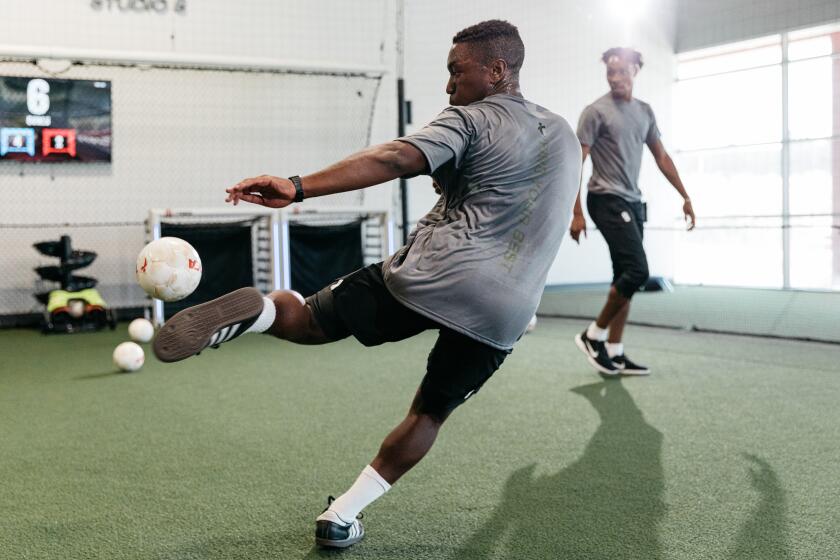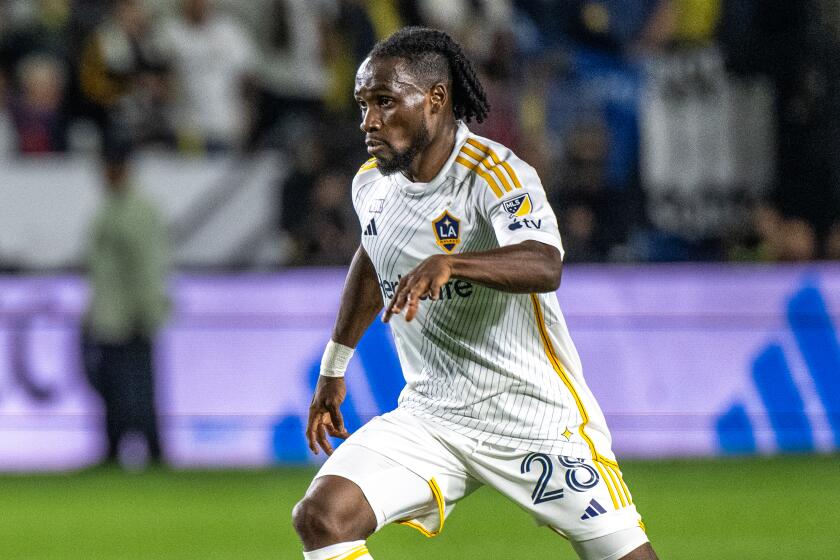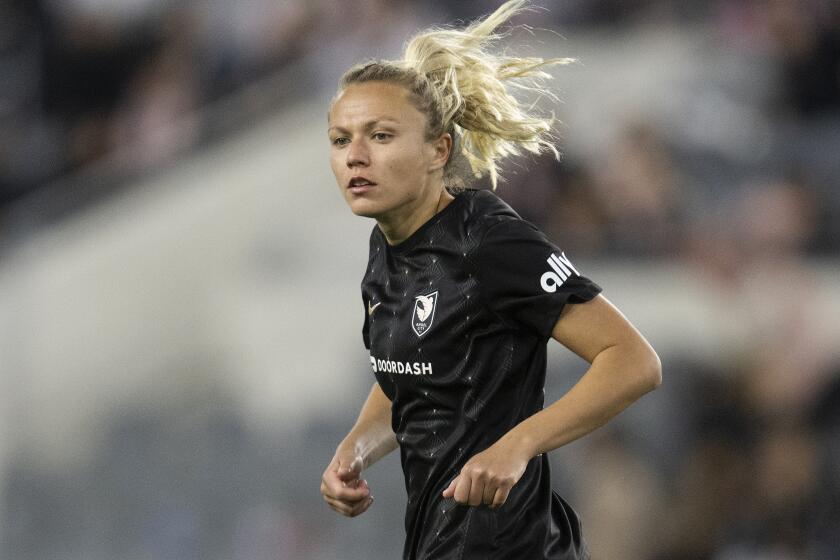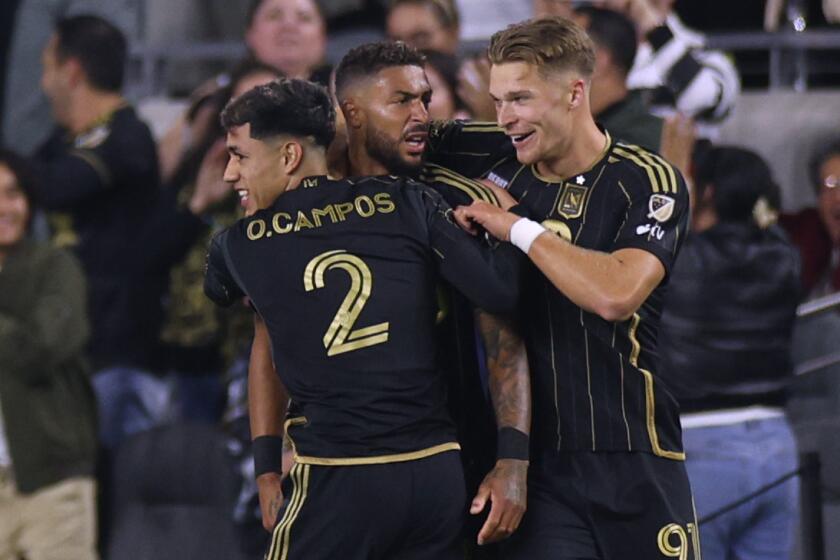LAFC reaches jersey, streaming deal with YouTube TV
The expansion Los Angeles Football Club has reached a multiple-year agreement with YouTube TV in which the subscription-content provider will place its name and logo on the team’s jerseys and stream the club’s locally televised games in English.
LAFC is thought to be the first professional sports franchise in North America to offer its games on a dedicated streaming channel. Terms of the agreement, which thrusts YouTube TV into the volatile sports-broadcasting business, were not publicly disclosed. A person affiliated with MLS and with knowledge of the situation said it was a three-year deal worth nearly $18 million.
A different over-the-air TV partner, likely to be Univision affiliate KMEX, will carry LAFC’s locally televised games in Spanish.
“This is a really compelling partnership that goes beyond just broadcasting the games,” LAFC President Tom Penn said. “YouTube TV is on our inaugural jersey. We expect that to be a globally recognized piece of clothing. And that red button is one of the most globally recognized icons on the planet.”
Penn, a co-owner of the team, said more-traditional broadcasters expressed interest in a deal but YouTube TV was a better fit.
“Philosophically, from the beginning, we always wondered whether we would be among the last of the old-style deals or the first of the new-style deals,” he said. “So when things are close or equal, it’s compelling to be new and next and forward-thinking.”
Thirty of LAFC’s 34 games will stream on a YouTube TV channel. The coverage will include 30-minute pregame and postgame shows. Those shows, as well as additional midweek programming, will be available nationwide. The game coverage will be geo-fenced, making it viewable only in Southern California.
Google-owned YouTubeTV will not produce the game coverage, instead partnering with MLS and LAFC. YouTube TV, available on the internet and mobile devices in 80 metro areas across the U.S., is a $35-per-month subscription service that also carries content from other providers, including ESPN, NBC Sports and Fox Sports as well as local over-the-air stations.
“We can offer both the nationally televised games and have the ability to bring local [programming] through our service,” said Angela Courtin, global head of YouTube TV and originals marketing. “We want to continue to push those boundaries.”
Local TV has been a tough market to crack for many MLS teams. The Galaxy, seven seasons into a league-record 10-year, $55-million contract with Spectrum SportsNet, averaged about 9,000 viewers a game last season, according to a spokeswoman for Charter Communications, which owns the cable network.
And while others have succeeded, even they are expanding into digital. Real Salt Lake has an over-the-air TV partner that has given the team control over game broadcasts that draw as many as 45,000 Utah households. But the team is expected to announce a deal soon that would also make its games available via a streaming service available on the internet and on mobile devices.
“MLS and all the teams, we’re kind of stuck in this ‘tweener phase right now,” said Trey Fitz-Gerald, Real Salt Lake’s vice president of broadcast and public relations. “That old model, that [broadcast] rights model that has driven sports value for the last 30 years, is falling apart. But nobody knows exactly what the new model is going to look like.”
Nationwide MLS games broadcast on ESPN, Univision or Fox Sports averaged fewer than 300,000 viewers per game, about what the New York Yankees averaged for their games last season on the regional YES Network.
That doesn’t necessarily mean fewer eyeballs on the games. It could mean fans are accessing games on other platforms such as the internet and mobile devices, said Daniel T. Durbin of the USC Annenberg Institute of Sports, Media and Society.
“We’re now at a turning point where the audience is actually diminishing for sports on television because it’s expanding for sports on alternative media,” Durbin said. “There are other reasons for it. But one of the strong reasons — especially with that target audience of millennials — is that they’re expanding their consumption of sports on what we would call alternative media but what are now becoming the standard media.”
Said Penn: “It’s just an overall trend in the business with the new skinny bundle offerings … that are alternatives to cable,” he said. “… This notion of any device, any time, whenever you want it, that’s what we’re embracing.”
LAFC has not chosen a play-by-play announcer nor an analyst for its YouTube coverage. The club is expected to announce soon an agreement with English- and Spanish-language radio partners.
Follow Kevin Baxter on Twitter @kbaxter11


